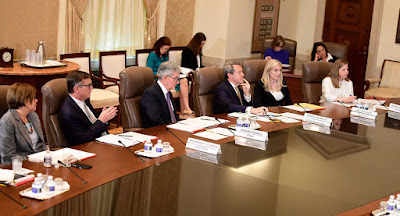Click here to read the original Cautious Optimism Facebook post with comments
 |
| Pre-pandemic Federal Open Market Committee meeting |
3 MIN READ – It’s no secret that the Fed was at least nine months behind the inflation curve in 2021, insisting for far too long that inflationary pressures were “transitory” even as it pushed the money supply, as measured by M2, up another 13% during the calendar year.
However the Cautious Optimism Correspondent for Economic Affairs and Other Egghead stuff is... well, cautiously optimistic that the Fed has finally woken up, now takes the inflation problem at least halfway seriously, and that a repeat of the 1970’s stagflation decade is extremely unlikely.
Recent notes from the December Federal Open Market Committee meeting reveal members considering raising “the federal funds rate sooner or at a faster pace than participants had earlier anticipated.” (from thehill.com)
And “some participants also noted that it could be appropriate to begin to reduce the size of the Federal Reserve's balance sheet relatively soon after beginning to raise the federal funds rate.”
Note they’re no longer talking about "tapering asset purchases" which is effectively expanding the balance sheet albeit at a slower pace than before. The conversation has changed to "reduce the size of the balance sheet" which means selling assets, a complete reversal of the FOMC's policy of the previous two years.
How quickly things have changed.
Accelerating rate hikes in 2022 is also a big turnaround given since mid-2020 the Fed has been saying interest rates will stay at zero through at least the end of 2022.
Even as recently as March of 2021 the Fed was signaling zero or near-zero interest rates through 2023.
https://www.afr.com/policy/economy/fed-to-keep-its-key-rate-near-zero-through-2023-20210318-p57bqk
Again, how quickly things have changed… now that they’ve woken up.
And what about a repeat of the 1970’s?
For those old enough to have memories of the “stagflation” decade, when one dollar in 1971 retained only 38 cents of purchasing power by 1983, it’s important to remember that the Arthur Burns and G. William Miller Feds were both full-throttle Keynesian—guided by that macroeconomic school that dominated government policy for nearly half a century (1936-1980).
Following their Keynesian playbook the 1970’s Fed deliberately printed money faster and faster every year, even in the face of rising inflation, in the belief that higher inflation was a good thing that would usher in full employment and faster economic growth "any moment now."
It famously failed, with Americans’ pocketbooks paying the price for their mistake.
So the 1970’s inflation wasn’t about being nine months slow waking up to the consequences of keeping a crisis-policy in place for too long. It was a decade-plus-long deliberate act, even in the face of consistently high-single digit and low-double-digit inflation, all in the Keynesian belief that “inflation might be high, but just a little more will fix all our problems... any moment now.”
Paul Volcker put an end to the insanity in 1981 when he was forced to raise interest rates to 21% to kill the monster of the Fed’s own creation.
The Economics Correspondent believes the Jerome Powell Fed is not the Arthur Burns or G William Miller Fed of the 1970’s.
Now that the mystery of whether the Fed will wake up and act seems to be answered, the pressing question of the next phase is:
1) Will the Fed have to make up for lost time and hike so aggressively that it precipitates a recession? Like the worker who oversleeps and speeds to work, causing an accident?
2) Or will the Fed be so worried about rate hikes creating a recession that it only taps the brakes a little, allowing inflation to keep running well above 2%?
Either way, by hitting the snooze button so many times the Fed has created quite a predicament for itself. It now faces the delicate task of slowing down its own inflation without tanking the economy in the process.
And if the Fed can’t find a way to thread that needle perfectly, then either persistent inflation or a recession will fall right into the Biden administration’s lap which in turn will get most of the political blame.
The consequences won’t entirely be the Biden White House's fault. It’s still mostly, but not all, the Fed’s.
But plenty of previous Republican presidents have also fallen victim to the same Fed missteps including Ronald Reagan who had to eat the 1981-82 Volcker recession (when unemployment peaked at 11.0%) and George H. W. Bush when Fed rate hikes produced the early 1990’s recession that, along with breaking his "no new taxes" pledge, cost him a second term.
Another Fed rate-hike campaign burst the 2000 dot-com tech bubble and handed George W Bush a recession just as he entered office, and an even more aggressive series of rate hikes burst the housing bubble triggering the inevitable financial crisis right before he left.
Meanwhile Bill Clinton entered office right as the Fed had cut rates and left them low for nearly eight years. And Barack Obama got the same benefit with zero interest rates at the start of his tenure which stayed near zero for both of his terms.
So sooner or later the law of averages was bound to catch up to a Democratic president who has to eat bad Fed policy too. The last one was Jimmy Carter in 1980.
(see St. Louis Federal Reserve Fed Funds chart for history of interest rates and recessions)
No comments:
Post a Comment
Note: Only a member of this blog may post a comment.